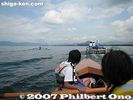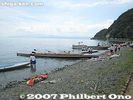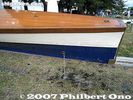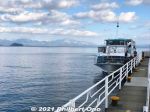 Image search results - "Takashi" Image search results - "Takashi" |

Omi Fair video taken on March 2, 2014 at Takashimaya Dept. Store in Nihonbashi, Tokyo. Funazushi, Omi beef, Biwa pearls, and more. We also saw Hiko-nyan.
|
|

Castle tower
|
|

Way to Takashimaya Dept. Store in Nihonbashi subway station.
|
|

On June 16, 2007, Imazu marked the 90th anniversary of the song by organizing a boat cruise on Lake Biwa and other events. Omi-Imazu Station had a sign directing guests to Imazu Port. 90周年の記念「琵琶湖周航クルーズ」の近江今津駅内
|
|

Way to Takashimaya Dept. Store in Nihombashi subway station.
|
|

Imazu Port. A large crowd of people waiting to board the chartered boat for a 3-hour cruise on Lake Biwa to commemorate the 90th anniversary of the song, Biwako Shuko no Uta.
|
|
|

The "Rio Grande" cruise boat awaits at Imazu Port on a miraculously sunny day during the rainy season. 梅雨でありながら、奇跡的にこんないい天気になった。今津港
|
|

Takashimaya got its name from Takashima, Shiga Prefecture.
|
|

Reception desk for passengers. A little over 100 people joined the cruise. クルーズの受付
|
|

1st floor of Takashimaya Dept. Store.
|
|

Boarding time at Imazu Port. In the forefront is a song monument for Biwako Shuko no Uta.
|
|

Exhibit of Nagahama bonsai plum trees and folding screen from Hikone, 1st floor of Takashimaya Dept. Store during the Grand Omi Fair.
|
|

Megan and Jamie Thompson about to board the boat. トンプソン姉妹
|
|
|

Boat name "Rio Grande" operated by Biwako Kisen. Named after Shiga's sister state in Brazil. There is also the "Michigan" paddlewheel boat named after Shiga's sister state in the USA.
|
|

Folding screen from Hikone (National Treasure).
|
|

Inside the front of the Rio Grande boat. 琵琶湖周航クルージング
|
|

PR exhibit for the Grand Omi Fair on the 8th floor.
|
|

Open deck at the rear. The boat departed at about 11:30 am.
|
|
|
|

We passed by various scenic spots such as Shirahige Shrine, noted for the torii gate in the lake.
|
|
|

1st floor of Takashimaya Dept. Store.
|
|

Shirahige Shrine 白髭神社
|
|

Grand Omi Fair on 8th floor
|
|

Shirahige Shrine torii as seen from the cruise boat.
|
|

Tourist corner with samurai armor of Hikone's Ii Clan.
|
|

Omi-Maiko with green pines on white sands. 近江舞子の「松は緑に 砂白き」
|
|
|

Omi-Maiko appears in the song.
|
|

Funa-zushi 鮒寿し
|
|

Rolling with the waves
|
|
|

Okino-shiraishi Rocks, a favorite resting place for birds which turned the rocks white from bird droppings. Four rocks stand 80 meters deep in the lake. Out of the water, the tallest stands 14 meters high. 沖の白石
|
|

Fish and shellfish from Lake Biwa
|
|

So what does "Coral shrine" mean in the song? (There's no coral in the lake.) "I think it just refers to a beautiful place..." 「珊瑚の宮」はどういう意味?
|
|

Ibuki Ham
|
|

We landed on Chikubushima for about an hour. Jamie and Megan also sang in English in front of the Verse 4 song monument.
|
|

Ibuki Ham
|
|

Jamie and Megan Thompson sing in English in front of the Verse 4 song monument, Chikubushima. Next time we need to have an amplifier.
|
|

Vegetable jam
|
|

Jamie and Megan Thompson sing in English in front of the Verse 4 song monument, Chikubushima. They sang up to Verse 4. ジェイミーとメゲン・トンプソン姉妹が歌う
|
|

Takashima Castle
|
|

Omi beef, each pack here cost over 2,000 yen. 近江牛
|
|

The man holds the 90th Anniversary tour sign as a guide for the tour guests.
|
|
|

Getting back on the boat. Little over a hundred people came on this cruise. If people knew it was gonna be such a beautiful day during this rainy season, more would have certainly come.
|
|

Stamp of Approval from Shiga
|
|

Sachiko Tsuji, the MC, interviews the sisters before they sang on the boat. 自動販売機前でインタービュー。船内の客は姉妹の顔や姿がほとんど見えへん。
|
|

Mochi making
|
|

Jamie and Megan Thompson sing in English while cruising on Lake Biwa. 船の真ん中で歌って自動販売機がバックになって最悪。客に背中を向くばかりで申し訳ない。船の一番前に歌いたいと頼んだけど...
|
|

Mochi
|
|

After they sang, there was a mad rush to buy the CD priced at 800 yen. 英語版CDの購入者が殺到。
|
|

Adoberry sweets, from Adogawa, Takashima.
|
|

Then they signed autographs on the CD. CDのサインを求める。
|
|

Adoberry sweets, from Adogawa, Takashima.
|
|

More autographs. 姉妹はやはり人気者。
|
|
|
|

Entrance to crafts booths. 工芸展
|
|

Water lilies. The melody of the song originally came from a song called "Hitsuji-gusa" which means water lilies.
|
|

Omi crafts booths
|
|

Water lily (Hitsuji-gusa). ひつじぐさ
|
|
|
|

Kimono in the middle costs 1,995,000 yen. However the most expensive thing I saw was a Buddhist altar selling for 40 million yen (lots of gold leaf).
|
|

After the boat cruise, there was a walking tour of Imazu. A special exhibition was held at the local community center in Imazu. 「周航の物語展」今津東コミセン
|
|

Making candles.
|
|

「周航の物語展」今津東コミセン
|
|

This showcase showed things from the old Daisan Koto Gakko college.
|
|

Student uniform for Daisan Koto Gakko school.
|
|

Daisan Koto Gakko Rowing club towel
|
|

Daisan Koto Gakko book of songs
|
|

Chojiya ryokan along the lake shore. Likely this is where Oguchi Taro and crew stayed. 丁子屋という旅館
|
|

Inside Chojiya. Very impressive Japanese-style inn with lake views.
|
|

Room in Chojiya ryokan.
|
|

Inside Chojiya. The inn is famous for serving duck.
|
|
|

Another local landmark was this former bank building designed by William Merrell Vories who designed many buildings in Shiga, especially in Omi-Hachiman.
|
|

Verse 3 Song Monument, Imazu. A lantern, at the end of the pier at Imazu Port. 三番の歌碑。今津港の桟橋。夜に赤く点灯。This is at the end of Imazu Pier. At night, this lamp lights up in red. You can see Chikubushima island and Mt. Ibuki in the background.
|
|

Inside former bank building.
|
|

Verse 3 Song Monument
|
|

In the evening during 5 pm-6:30pm, a slide show lecture about Oguchi Taro and Yoshida Chiaki was given by Iida Tadayoshi, a song researcher. Held at a hotel in Imazu. 歌と映像でつづる「小口太郎と吉田千秋の物語」講演会
|
|

German-made accordian used by Yoshida Chiaki was also on display.
|
|

View of Imazu shore from hotel
|
|

A reception was held afterward in the hotel. The mayor of Takashima, Hidekazu Kaito, speaks. I gave him a copy of our CD. 高島市長 海東英和
|
|

Verse 3 Song Monument is written with Verse 3.We drift from wave to wave, straying aimlessly.
On shore we see red fire, brings back memories.
With our sights set nowhere, rolling with the waves.
Today is Imazu or, Nagahama huh.
Nami no mani mani, tadayoeba
Akai tomaribi, natsukashimi
Yukue sadamenu, nami makura
Kyo wa Imazu ka, Nagahama ka
浪のまにまに 漂えば
赤い泊火 懐かしみ
行方定めぬ 浪枕
今日は今津か 長浜か
|
|

Interestingly, the mayor's first name "Hidekazu" means "English-Japanese." The next day, at the choir contest, he told us that he listened to and liked our song.
|
|

Imazu Port. Verse 3 Song Monument is at the end of the dock. The same dock used by boats going to Chikubushima. The dock is usually closed.Chikubushima island and Mt. Ibuki can be seen.
|
|

Kanpai!
|
|

Meeting Iida Tadayoshi, song researcher and former NHK announcer.
|
|

In the end, we all sang the song, including the mayor of Takashima.
|
|
|
|

最後に皆で周航歌を歌う。
|
|
|

Takashima Castle 高島城
|
|

Biwako Shuko no Uta Birthplace Monument, Imazu. This is Imazu's second monument for the song. 全歌詞碑の「琵琶湖周航の歌」誕生の地 今津。今津港。背景には竹生島行きの船。Imazu has two monuments for the song. The first one is a lamp at the end of the pier (visible in this picture on the right of the boat). That was for Verse 3 which is written on the lamp post.
Later in 1994, Imazu town built this red clay monument to commemorate the song's birth in Imazu. The entire lyrics is also engraved. It is next to the Imazu boat pier where boats depart for Chikubushima. Looks like a red flame, but it's shaped after the geographical shape of Imazu town.
|
|

The monument is engraved with the entire song and a picture of rowers.
|
|

Imazu Port. The song monument is on the right. Looks like a "red fire" as mentioned in the song.From Imazu Port, you can easily go to Chikubushima island by boat, from where you can take another boat to Hikone or Nagahama. Going vice versa is possible too. It's a great way to traverse the lake.
See more photos of Imazu here.
|
|

Bridge to castle park
|
|
|
|

Biwako Shuko no Uta Shiryokan (Lake Biwa Rowing Song Museum) moved to this building's 1st floor and opened on April 1, 2020. This is the Imazu-Higashi Community Center (今津東コミュニティセンター).Right across from the Imazu Shimin Kaikan concert hall.
|
|

The museum sign includes English! Official English name is "Lake Biwa Rowing Song Museum." 琵琶湖周航の歌資料館
|
|

Entrance to the new Biwako Shuko no Uta Shiryokan (Lake Biwa Rowing Song Museum) in Imazu. 琵琶湖周航の歌資料館
|
|

The museum has various panel exhibits, videos, etc. Currently, no explanations in English. Tokiko Kato scored a national hit with the song in 1971.
|
|

Model of fixed-seat boat used during Oguchi Taro's time in 1917.
|
|

Exhibit for Oguchi Taro who composed the song.
|
|
|

CD listening station for many cover versions by famous Japanese singers and groups. There are many, and you can listen to each of them.The song was included in a record for the first time in 1958 when Kyoto University made an album of its university songs on the 90th anniversary of the school's founding. In 1961, a chorus group named Boney Jacks recorded the song in an album of Japanese songs. And so did singer Peggy Hayama in 1962.
|
|
|
|

Imazu shore
|
|

Imazu road along the lake shore, near Chojiya inn.
|
|

About the castle
|
|

Stairs to castle tower
|
|

Inside castle tower
|
|

Inside castle tower
|
|

View from castle tower
|
|

View from castle tower
|
|

View from castle tower
|
|

View of moat from castle tower
|
|

View of garden from castle tower
|
|

On Aug. 8, 2007, I was allowed to join the Imazu Jr. High School Rowing Club as they rowed from Nagahama to Imazu. Photo: A briefing by the club's coach before departure in front of a minshuku lodge near Nagahama Castle.
|
|

This "Biwako shuko" (Rowing around Lake Biwa) between Imazu and Nagahama was the club's annual summer tradition since 1995. Photo: Assembling a two-man kayak.
|
|

On the day before, they were supposed to row from Imazu to Nagahama, but high waves forced cancellation. So they were bused to Nagahama where they stayed overnight. Photo: Carrying the kayak to the lake, passing by Nagahama Castle.
|
|

Almost 50 members in the club, and almost all of them participated in this rowing trip. Some of them did this for the third time. Photo: Carrying life vests. All rowers are required to wear life vests.
|
|

In the morning, two fishing boats pulled the rowing boats from Imazu to Nagahama Port where we met them here. 今津中学校ボート部の琵琶湖周航
|
|

They used five boats to row, including these two ocean scull boats.
|
|

Two fixed-seat boats were also used.
|
|

And girls on the other fixed-seat boat. These boats have fixed seats which do not slide as in modern rowing boats. This boat is a replica of the fixed-seat boat used 90 years ago by Oguchi Taro and crew when he wrote the song, Biwako Shuko no Uta.
|
|

I wanted to experience rowing this fixed-seat boat on Lake Biwa, and rowed with these jr. high girls from Nagahama Port. 千秋・太郎号のフィックス艇
|
|

Garden
|
|

"We're children of the lake, off to wander 'round..." (Mt. Ibuki in the distance)「われは湖の子...」
|
|

"This journey fills my heart with intense happiness..."「さすらいの 旅にしあれば しみじみと」
|
|

Yes, replenishing your fluids is important...
|
|

We were far behind, so a support boat pulled us along. Two fishing boats provided support for the rowing trip.
|
|

"Hira and Ibuki too, only but a dream"
|
|

After about an hour, our first on-shore break, nears Sports no Mori in northern Nagahama.
|
|

Our fixed-seat boat 千秋・太郎号のフィックス艇
|
|

Twin fixed-seat boats. One is named "Chiaki/Taro" and the other is called "Yodo," after Yodogawa River in Osaka. Lake Biwa's water feeds Yodogawa River.
|
|
|
|

Rowers changed boats. Those without a rowing boat were transported on the fishing boats.
|
|

Ocean scull
|
|

Chikubushima and ocean scull
|
|

Chikubushima and fixed-seat boat
|
|

Three ocean sculls wander in front of Mt. Ibuki
|
|

Chugging along on a fishing boat.
|
|

Getting a free ride were these girls heading for Sugaura, a small town on the northern shore of Lake Biwa.
|
|

Ocean scull rowers and a sickly Chikubushima going bald. The numerous cormorants are killing off the trees on the island.
|
|

Heading toward Sugaura, Nishi-Azai in northern Lake Biwa.
|
|

Approaching Sugaura
|
|
|

Boys posing for a picture at Sugaura
|
|

Lunch break at Sugaura, a scenic lakeside town. It is also where the scenic Oku Biwako Parkway road starts.
|
|

Fixed-seat boat フィックス艇
|
|

I love the design of this boat. 千秋・太郎号のフィックス艇
|
|

This boat's name is "Chiaki/Taro," named after the writer (Oguchi Taro) and composer (Yoshida Chiaki) of the song, Biwako SHuko no Uta.
|
|
|

Sugaura
|
|

Departing Sugaura
|
|

Departing Sugaura with Chikubushima in the background.
|
|

Fixed-seat boats
|
|
|

Fishing boat for human transport. It was a very hot day with no wind.
|
|

Boys watch their classmates row.
|
|

Rowing away from Sugaura
|
|

"With our sights set nowhere, rolling with the waves..."「ゆくえ定めぬ、波枕」
|
|

Off Makino Sunny Beach
|
|

Fixed-seat boat with Mt. Ibuki and Chikubushima in the background. 千秋・太郎号のフィックス艇
|
|

"Today is Imazu or, Nagahama huh..."「今日は今津か 長浜か」
|
|
|

All-girl crew pose for a picture. The rowing club has more girls than boys. はい、ポーズ!
|
|

Sleek boat slicing through the water.
|
|
|

They refused to be pulled by the fishing boat. They wanted to row all the way home to Imazu.
|
|

Catch, row, catch, row...
|
|
|
|

Fixed-seat boats and ocean sculls rendezvous toward home in Imazu.
|
|

Target destination in sight
|
|

Imazu boathouse
|
|

Bringing the boat to dock.
|
|

The boat is first carried onto a trolley.
|
|
|

Hauling the fixed-seat boat to the boat house
|
|
|
|
|
|

Water drain
|
|

Fixed seat
|
|

Oarlock on fixed-seat boat
|
|

Cox seat and rudder (removed). Beautiful boat, and I'm darn happy to have rowed on this rare boat. Felt almost like Oguchi Taro.
|
|

Inside the boat house
|
|

"Tell us my friends your stories, with your fervent hearts."「語れ我がが友 暑き心」 Also see my YouTube video here.
|
|

My video of Imazu Junior High School Rowing Club on Lake Biwa.
|
|
|
|

This birch tree is a Natural Monument
|
|

Birch tree plaque
|
|

Imazu Vories Museum in Imazu, Takashima, a former bank building designed by William Merrell Vories. Now a coffee shop and exhibition space. MAP
|
|

Imazu Church, designed by William Merrell Vories. This is next to the former bank building. MAP
|
|

Approaching Imazu in winter.
|
|

Interlaken at Imazu Port.
|
|

Imazu Port with Chikubushima and Mt. Ibuki in the background.
|
|

Walking to Imazu Port on the boat dock. New Imazu Port building.
|
|

Inside the new Imazu Port building made of wood. Waiting room.
|
|

Inside the new Imazu Port building. That's the ticket office.
|
|

At Imazu Port is another monument for Biwako Shuko no Uta (Lake Biwa Rowing Song). Interlaken also leaves for Chikubushima.
|
|

From Imazu Port, it's a short walk to JR Omi-Imazu Station to catch the JR Kosei Line (湖西線) to Kyoto.
|
|

Harie is a unique rural neighborhood where homes draw clean water from an ever-flowing spring directly from the ground into private wells called kabata. A local NPO conducts tours of the area and homes with kabata.Harie is in Takashima, Shiga, near JR Shin-Asahi Station on the Kosei Line, the gateway to Shin-Asahi and Harie. 新旭駅 MAP
|
|

Statue in front of JR Shin-Asahi Station east side.
|
|

JR Shin-Asahi Station west side.
|
|

On the west side of JR Shin-Asahi Station is this building where the local tourist info office is. You can rent bicycles here too.
|
|

Road to Harie. It's about a 25 min. walk from Shin-Asahi Station. The water stream on the right was muddy to my surprise.
|
|

When I visited Harie in late April, the water, which supposed to be crystal clear, was muddied from the rice paddies being drained. Late April to June is probably not a good time to visit Harie due to the rice paddies.
|
|

Bird looks for its meal in the stream.
|
|

Sign points the way to Harie.
|
|

Sign saying that you are entering Harie where water is a treasure. The important thing to understand about Harie is that you need a guide to see the kabata water springs in private homes.
|
|

A local non-proft group called Harie Shozu-no-Sato Committee conducts tours of Harie. For 1,000 yen, they will spend 90 min. to take you to see numerous kabata in private homes. Call 0740-25-6566 to make reservations. hariekabata.comOr email: shozunosato@lapis.plala.or.jp
|
|

In 2014, The Shozu-no-Sato Committee 針江生水の郷委員会 won the top Ecotourism Grand Prize エコツーリズム大賞 sponsored by the Japan Ecotourism Society and Environment Ministry. Harie Hiyoshi Jinja Shrine 針江日吉神社
|
|

The guided tour is well worth it. I highly recommend it. The Harie-Okawa River would be crystal clear if it weren't for the rice paddies being flooded. MAP
|
|

The tour starts at the Harie Kominkan community center. They don't have English-speaking guides, so bring a translator. 針江公民館
|
|
|

Large carp in the roadside streams help keep the water clean by eating food scraps from washed dishes, etc.
|
|

Many houses and wooden walls in Harie are black.
|
|
|
|

The wooden walls are actually half-burnt, almost like charcoal.
|
|

This is the first kabata we visited. There is a pipe which spews the spring water from 12 to 25 meters below the ground. The original water source is called moto-ike.
|
|

Most kabata have two water sinks (ike), the one on the right (tsubo-ike) is for washing summer vegetables like tomatoes, eggplants, and cucumber. The one on the left (hata-ike) is for washing dirty root vegetables like daikon, carrots, and spinach. 川端
|
|

Imagine having a spring in your own home spewing drinkable water 24/7 for free. This kabata has a few baskets. The oblong one is used for fish, and the ones on the right were used to dry bowls.
|
|

Kabata shed is usually either attached to the main house or right outside it.
|
|

When they wash pots and pans, the koi fish eat the food scraps to keep the water clean. Also see my YouTube video here.
|
|

Harie Okawa River has baikamo underwater flowers. It was muddy when I visited in late April because of the rice paddy flooding. 針江大川
|
|
|
|

Baikamo in Harie-Okawa River
|
|

A shopping stop was here where they sold these model dragonflies well-balanced on its nose, called Kabata Tonbo.
|
|

Kabata shed.
|
|

A roadside spring.
|
|

Roadside spring with waterwheel.
|
|

Roadside spring, one of the oldest and longest lasting.
|
|

Sign saying that Harie is not a tourist spot, that a guide is required to see the kabata.
|
|

Kabata shed of a lake fisherman.
|
|

Can't tell in the photo, but these were the biggest carp you've ever seen.
|
|

Another shopping break was this fisherman's shop where you can buy ayu sweetfish caught in Lake Biwa.
|
|

Sometimes the kabata is outdoors with no shelter.
|
|
|
|

Shodenji temple
|
|

Shodenji temple belongs to the Soto Zen sect of Buddhism. 正伝寺
|
|
|

Shodenji temple has its own spring spewing drinkable water.
|
|

Shodenji temple's kabata. Women like this water as it feels creamy and makes their skin feel smooth and soft.
|
|

Shodenji temple also has a spring feeding this pond with various fish.
|
|
|
| 1170 files on 5 page(s) |
1 |
 |
 |
|